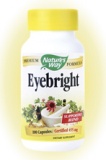| Eyebright is a native British and European plant; naturalised locally in parts of the USA. Eyebright is also known as euphrasia officinalis, euphrasia, meadow eyebright, and red eyebright. Euphrasia is a small downy annual herb which grows in meadows,
pastures and other grassy areas. It has tiny oval leaves and small, scallop-edged, white flowers with yellow spots and a black center resembling an eye. The flowers are small, white or red and often tinged with purple streaks with a yellow spot in the throat.
Eyebright has been used as a folk medicine to treat eye inflammations and infections, coughs, and poor memory. Eyebright has been used since the middle ages as a tonic and astringent. The constituents of eyebright include vitamin A, vitamin C, vitamin D, vitamin B complex, iron, silicon, iodine, copper, and zinc. Other ingredients of eyebright include flavonoids (rutin and quercetintannins), iridoid glycosides, essential fatty acids, glycoside aucuboside, caffeic and ferulic acids, sterols, choline, and a volatile oil.
Eyebright is primarily used to treat eye irritation and inflammation. It is particularly beneficial for sore, itchy eyes which may have a discharge. The flavonoids in eyebright act as anti-inflammatory agents that can help relieve inflamed mucous membranes of the eyes, sinuses, and upper respiratory tract. The flavonoids in eyebright act as anti-inflammatory agents that can help relieve inflamed mucous membranes of the eyes, sinuses, and upper respiratory tract.
Eyebright can be made into a tea, liquid tincture or tablet. Taken internally, it has a powerful anticatarrhal action and may be used in nasal catarrh, sinusitis and other congestive states. Possible side effects of eyebright include confusion, headache, itching, eye pressure, sneezing, stuffy nose, vision disturbances and weakness. |
 Herbal Eyebright formula is a supportive blend of five benefical herbs. It contains goldenseal, bayberry, raspberry and eyebrigh (sterm, leaf, flower, fruit). Best results are obtained with Herbal Eyebright when used in conjunction with a low mucous generating diet. Click here for more information.
Herbal Eyebright formula is a supportive blend of five benefical herbs. It contains goldenseal, bayberry, raspberry and eyebrigh (sterm, leaf, flower, fruit). Best results are obtained with Herbal Eyebright when used in conjunction with a low mucous generating diet. Click here for more information.